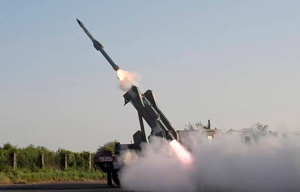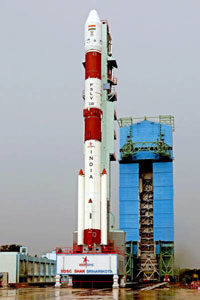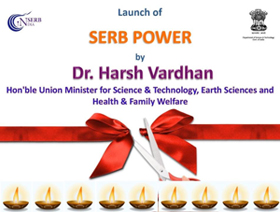November 2020 Science and Technology
Sakshi Education

- IRNSS accepted as a component of the World Wide Radio Navigation System
The Indian Regional Navigation Satellite System (IRNSS) has been accepted by the International Maritime Organization (IMO) as part of the World Wide Radio Navigation System (WWRNS) operating in the Indian Ocean region.
This will enable merchant ships to use IRNSS to obtain location information similar to GPS and GLONASS to assist in navigating longitude in seawater in areas covered by 50°N latitude, 55°E longitude, 5°S and 110°E.
IRNSS is an independent regional navigation satellite system developed by India. It aims to provide accurate location information services to assist ships in the Indian Ocean waters.
India has become the fourth country in the world to have an independent regional navigation satellite system, which has been recognized by the IMO as a part of WWRNS.
The other three countries whose navigation systems have been approved by the IMO are the United States, Russia and China.
- Ravi Shankar Prasad launches international version of UMANG App
To mark the occasion of 3 years of UMANG and 2000 plus services milestone, an online conference was organized under the chairmanship of Minister for Electronics and Information Technology, Ravi Shankar Prasad.
Mr Prasad launched the UMANG’s international version in coordination with Ministry of External Affairs for select countries that include USA, UK, Canada, Australia, UAE, Netherlands, Singapore, Australia and New Zealand. It will help Indian international students, NRIs and Indian tourists abroad, to avail Government of India services, anytime. It will also help in taking India to the world through ‘Indian Culture’ services available on UMANG and create interest amongst foreign tourists to visit India.
The international version of the UMANG App can be downloaded from Play Store of specific countries. The Union Minister also launched an e-Book which presents major milestones of UMANG and major services available on UMANG App classified into various categories. Mr Prasad also unveiled the newly instituted UMANG Awards for Partner Departments of Centre and States based on the highest number of transactions across services. Speaking on the occasion, Mr Pasad said that Digital India must lead to digital inclusion and it must bridge the digital divide. He said, it must be achieved by technology which is home grown and also inclusive.
The UMANG mobile app -Unified Mobile Application for New-age Governance is a Government of India all-in-one single, unified, secure, multi-channel, multi-lingual, multi-service Mobile App. providing access to high impact services of various Government of India Departments and State Governments.
- India successfully test fires BrahMos cruise missile land-attack version
Recently, India has successfully test-fired a land-attack version of the BrahMos supersonic cruise missile from the Andaman and Nicobar Islands.
The test by the Army comes over a month after the Naval version of BrahMos was successfully test fired from Indian Navy’s indigenously-built stealth destroyer INS Chennai.
The range of the missile has been extended to 400 km from the original 290 km but its speed has been maintained at 2.8 Mach or almost three times the speed of sound.
The test was done in a “top-attack” configuration.
Most modern missiles, including BrahMos, can be fired in both top-attack and direct attack modes.
In top attack mode, the missile is required to climb sharply after launch, travel at a certain altitude and then fall on top of the target.
In direct attack mode, the missile travels at a lower altitude, directly striking
These tests are a display of India’s tactical cruise missile triad, i.e. launch capability from land, sea and air platforms.
India has already deployed a sizable number of the original BrahMos missiles and other key assets in several strategic locations along the Line of Actual Control (LAC) with China in Ladakh and Arunachal Pradesh.
The test marks the achievement of a critical milestone in enhancing India’s capability of engaging enemy’s vitally important targets in depth areas.
In the last two-and-half months, India has test fired a number of missiles including an anti-radiation missile named Rudram-1 which is planned to be inducted into service by 2022.
- Chang’e-5 Mission Launched by China
China has launched an unmanned spacecraft to bring back lunar rocks, the first attempt by any nation to retrieve samples from the Moon in four decades.
The Chang’e-5 mission, named after the ancient Chinese goddess of the moon, will seek to collect lunar material to help scientists understand more about the moon’s origins and formation.
Launch: The Long March-5 Y5 rocket, carrying the Chang’e-5 spacecraft, was launched from Wenchang Space Launch Center (China).
Key Task of the Mission: To drill 2 meters beneath the moon’s surface and scoop up about 2 kilograms of rocks and other debris to be brought back to Earth.
Upon entering the moon's orbit, the spacecraft is intended to deploy a pair of vehicles to the lunar surface, a lander and an ascender.
A lander will drill into the ground, then transfer its soil and rock samples to an ascender that will lift off and dock with an orbiting module.
There will be an attempt to collect 2 kg of samples in a previously unvisited area in a massive lava plain known as Oceanus Procellarum, or “Ocean of Storms”.
Area of the moon where the spacecraft is due to land is 1-2 billion years old.
If this is successful, the samples will be transferred to a return capsule that will return them to Earth, with a landing in China's Inner Mongolia region.
The entire mission is scheduled to take around 23 days.
If the mission is completed as planned, it would make China only the third country to have retrieved lunar samples, joining the United States and the Soviet Union.
The Apollo programme (which first put men on the moon), the United States landed 12 astronauts over six flights from 1969 to 1972, bringing back 382 kg of rocks and soil.
The Soviet Union Lead Luna: Deployed three successful robotic sample return missions in the 1970s. The last, the Luna 24, retrieved samples in 1976 from Mare Crisium, or “Sea of Crises” - a lunar basin.
The Apollo-Luna sample zone of the moon, while critical to our understanding, was undertaken in an area that comprises far less than half the lunar surface.
Subsequent data from orbital remote sensing missions have shown a wider diversity of rock types, mineralogies and ages than represented in the Apollo-Luna sample collections.
- GenePath Diagnostics wins ?2.5 crore grant
Pune-based lab will develop cost-effective, mass-scale, point-of-care platform to detect HPV virus.
The city-based GenePath Diagnostics, a next-generation diagnostics company, has won the prestigious United States–India Science and Technology Endowment Fund (USISTEF) grant of ?2.5 crore to develop a cost-effective and highly sensitive mass-scale processing platform for the detection of HPV (Human Papilloma Virus), which is said to be the chief cause of cervical cancer.
GenePath will develop the product over the next two years, said a statement released by the firm.
The objective of the platform is to help detect pathogenic HPV strains from self-collected samples in low-resource, rural areas to help bring down mortality rates while reducing the burden on the country’s healthcare infrastructure.
The aim of the fund is to support and foster joint applied R&D to generate public good through the commercialisation of technology developed through sustained partnerships between U.S. and Indian researchers and entrepreneurs.
The governments of the United States (through the State Department) and India (through the Department of Science & Technology) had jointly established the USISTEF for the promotion of activities that lead to innovation and entrepreneurship through the application of science and technology.
- Navy inducts two Sea Guardian drones on lease from U.S.
Two American MQ9B Sea Guardian unarmed drones have been inducted by the Indian Navy.
The drones would be on lease with India for one year.
MQ9B Sea Guardian is the maritime variant of the Predator MQ9 Unmanned Aerial Vehicle (UAV).
It has a maximum endurance of 40 hours and a maximum flying altitude of 40,000 feet.
It has a 3600 maritime surveillance radar and an optional multimode maritime surface search radar.
It can be used in operations such as Anti-Surface Warfare, Anti-Submarine Warfare, Humanitarian Assistance/Disaster Relief, Search and Rescue, Law Enforcement (Drug Trafficking, Illegal Immigration and Piracy), etc.
The Navy has for the first time inducted two surveillance drones through a lease agreement with an American firm, using the emergency powers granted by the Centre to the Armed forces amid the China standoff.
Under the emergency power, the government has granted emergency funds up to Rs. 500 crore per procurement project to the three armed services to buy ammunition and weapons in view of the escalating border standoff with China.
Drones were procured under the option for leasing military platforms introduced in the Defence Acquisition Procedure (DAP) 2020.
The drones are meant for carrying out surveillance in the Indian Ocean Region and can be deployed on the China border if asked for and if needed.
Already the Navy's P8I Poseidon aircraft have been deployed in Ladakh.
The P-8I aircraft is a variant of the P-8A Poseidon aircraft that have been developed by Boeing company.
Boeing’s P-8A Poseidon is designed for long-range Anti-Submarine warfare (ASW), Anti-Surface Warfare (ASuW), and intelligence, surveillance and reconnaissance (ISR) missions.
As part of its force restructuring to offset budgetary constraints, the Navy is looking to induce more unmanned solutions in future.
Till the time the government approves buying the drones, which has to get the Defence Acquisition Council's nod, leasing is a more economic and viable option.
The Defence Acquisition Council is the highest decision-making body in the Defence Ministry for deciding on new policies and capital acquisitions for the three services (Army, Navy and Air Force) and the Indian Coast Guard.
- QRSAM Missile System Achieves Major Milestone
 India test fired all-weather Quick Reaction Surface-to-Air-Missiles at the Chandipur Test Fire Range. It is called QRSAM and is a canister-based system.
India test fired all-weather Quick Reaction Surface-to-Air-Missiles at the Chandipur Test Fire Range. It is called QRSAM and is a canister-based system.
The missile is capable of striking aerial target at a height of 15 km. It is launched from mobile two vehicle system. One of the vehicles in the system carries the missile and the second carries the radar. The radar can track 100 targets simultaneously. Also, it is capable of engaging six targets simultaneously.
The system is capable of detecting and tracking targets on the move and engaging target with short halts. The system is designed to give air defence coverage against strike columns of Indian Army.
The radar tracked the Banshee target from farthest range and missile was launched when target was within kill zone and achieved the direct hit with terminal active homing by RF Seeker guidance.
- CSIR-SERC, Chennai Develops Indigenous Emergency Retrieval System (ERS) for Power Lines
Council of Scientific and Industrial Research (CSIR), constituent laboratory Structural Engineering Research Centre (SERC) based in Chennai, has developed an indigenous technology, Emergency Retrieval System (ERS), for quick retrieval of power transmission in the event of failure of transmission line towers.
At present, the ERS systems are imported and the cost is relatively high. This technological development will enable the manufacturing in India for the first time, which will be an import substitute and will cost about 40% of imported systems.
ERS is a lightweight modular system that is used as temporary support structure to restore power immediately after the collapse of transmission line towers during natural calamities such as cyclone/earthquake, or manmade disruptions.
Made of structurally highly stable box sections, ERS is lightweight, modular and reusable.
ERS can be assembled quickly at the disaster site for restoration of power in 2-3 days, whereas the permanent restoration may take several weeks.
This development is very significant as failure of transmission lines severely impact lives of common people and causes huge monetary loss to the power companies.
- SpaceX’s ‘Resilience’ Lifts 4 Astronauts into New Era of Spaceflight
SpaceX launched four astronauts into the space under Mission Crew 1. The Crew Dragon capsule becomes the first spacecraft to be certified by NASA after 40 years. Being the first in a series, there will be regular flights by the SpaceX to the International Space Station.
The SpaceX Falcon 9 rocket was used to launch the spacecraft and is reusable. The SpaceX has scheduled to launch two more crewed flights in 2021. The mission was initially planned to be launched in July 2020. However, it was postponed due to covid-19 pandemic.
The spacecraft carried four astronauts. It includes three Americans and one Japanese. The spacecraft was launched to the International Space Station. The crew named the spacecraft as “Resilience”. The astronauts are to stay at the International Space Station for around six months.
- Param Siddhi secured 63rd rank in list of most powerful supercomputers in world
Param Siddhi is a high-performance computing-artificial intelligence (HPC-AI) supercomputer that was established at C-DAC under the National Supercomputing Mission.
Param Siddhi has secured rank 63 in TOP 500 most powerful non-distributed computer system list in the world.
Param Siddhi was jointly developed by Ministry of Electronics and Information Technology and Department of Science and Technology.
The supercomputer has a speed of 5.267 petaflops. It has now got the recognition of non-distributed super computer systems. Param Siddhi was built on NVIDIA DGX SuperPOD reference architecture networking.
India is currently implementing 3rd phase of National Supercomputing Mission (NSM). Government of India has allocated Rs 4,500 crore. The main aim of the NSM is to install 70 supercomputers in third phases.
In 2015, Government of India announced National Supercomputing Mission. The Mission will support “Digital India” and “Make in India” initiatives. Under the NSM, the first supercomputer of India was installed in Indian Institute of Technology (BHU) Varanasi. It was named as “ParamShivay”.
- Scientist’s joins United Nations to tackle misinformation on Covid-19 vaccines
The United Nations has collaborated with The Vaccine Confidence Project at the University of London’s School of Hygiene and Tropical Medicine to undertake Team Halo, an initiative which aims to counter the misinformation around Covid-19 vaccines.
More than 100 scientists from different parts of the world have come together under the project.
Under the initiative, the scientists will create social-media friendly videos on COVID-19 vaccine science based on their personal experiences.
Team Halo will act as a communication platform for the scientists working on COVID-19 vaccines.
Globally, the initiative is supported by scientists who are involved in the race of coronavirus vaccine development across the world’s top institutes.
Team Halo aims to highlight the work undertaken by scientists in the UK, USA, South Africa, Qatar, UAE, France, Spain, Peru, Canada, India and Brazil and create a platform for communication between the scientists working on Covid-19 vaccines and the citizens of these countries.
In India, over 22 scientists have joined Team Halo from renowned institutes such as Institute of Medical Sciences and Sum Hospital, Bhubaneswar; PGIMER, Chandigarh; Nizams Institute of Medical Sciences, Hyderabad; IIT Indore; Christian Medical College, Vellore; SRM Research Institute, Chennai; and Deep Children's Hospital and Research Centre, Gandhidham.
- ISRO to launch first crewless Gaganyaan flight by end of 2021
The first crewless flight as part of the preparations for the ambitious Gaganyaan project originally planned for this year, will now only happen at the end of next year.
ISRO will eventually also launch a second crewless flight, now scheduled for 2022 before launching humans into space.
ISRO flagged off the first human rated S200 motor case for Gaganyaan’s first crewless mission. “The high thrust solid propellant strap-on boosters — S200 — play an important role in the human rated GSLV MkIII.
In order to human rate the booster, many new design features have been introduced in the hardware.
The next step would be to achieve human rating of all the hardware required for the mission.
The reliability targeted for human-rated launch vehicles is 0.99, which means statistically only 1 out of 100 can be unreliable. And, for the crew escape system, which is very crucial, the target is greater than 0.998, which means 100% reliability.
- The storage tale of two vaccines
After Pfizer announced encouraging results of its mRNA vaccine for COVID19 based on an interim analysis of a large Pase3 trial that is underway, data from the Phase3 trial of the vaccine of the U.S.based Moderna revealed very encouraging results.
The interim results of Moderna’s mRNA vaccine show that it has 94.5% efficacy in preventing COVID19.
The interim analysis, which was based on 95cases, found that 90 participants in the placebo group had symptoms of COVID19, while only five participants in the vaccinated group had developed symptoms.
Importantly, Moderna revealed that the vaccine might be able to prevent severe disease.
The vaccine produced by Moderna is relatively stable at higher temperatures than the Pfizer vaccine. The thermostability of the Pfizer vaccine lies between -70 degree celcius to -80 degress. On the other hand, the Moderna vaccine remains stable at even -20 degrees.
At -20 degress, the Moderna vaccine can remain stable for 6 months, at 2-8 degress – 30 days and at room temperature, its shelf life is upto 12 hours.
Developing areas will find it difficult to contain these vaccines due to cold storage constraints.
- Willow Warbler sighted for the first time in country
The willow warbler (Phylloscopus trochilus), one of the longest migrating small birds that breeds throughout northern and temperate Europe and the Palearctic, has been sighted for the first time in the country in Thiruvanathapuram.
“The abnormal behaviour, shape, and nonfamiliarity with other warblers commonly seen in this area is what catches the attention of the viewer.
The bird weighs around 10 g and it has long wing feathers that help it fly long distances.
Usually seen in European and the Palearctic regions, the birds migrate to sub-Saharan Africa during early winter.
Warblers are generally difficult to identify owing to the small size and change in plumage twice a year.
They are also the most difficult groups of birds to identify in the field for their striking resemblance to each other.
- EOS-01, India’s latest earth observation satellite launched
 India’s latest all-weather earth observation satellite EOS-01 launched by the Indian Space Research Organisation (ISRO) using the workhorse rocket PSLV-C49.
India’s latest all-weather earth observation satellite EOS-01 launched by the Indian Space Research Organisation (ISRO) using the workhorse rocket PSLV-C49.
Nine other customer satellites also carried into space by the rocket. Four each are from the United States and Luxembourg, while another is a technology demonstrator from Lithuania.
It is launched from the launch pad at the SatishDhawan Space Centre, Sriharikota in southern Andhra Pradesh, close to Chennai.
ISRO had planned more than 20 satellite launches in the fiscal year 2020-21, including high profile missions like Aditya L1, the first exploratory mission to Sun, and unmanned Gaganyaan, the precursor to India’s first manned space flight.
EOS-01 is nothing but another Radar Imaging Satellite (RISAT) that will work together with RISAT-2B and RISAT-2BR1 launched last year.
EOS-01 was initially named RISAT-2BR2, and was supposed to be the third of the three-spacecraft constellation aimed at providing all-weather round-the-clock service for high-resolution images.
EOS-01, ISRO is moving to a new naming system for its earth observation satellites which till now have been named thematically, according to the purpose they are meant for.
For example, the Cartosat series of satellites were meant to provide data for land topography and mapping, while the Oceansat satellites were meant for observations over sea. Some INSAT-series, Resource sat series, GISAT, Scatsat, and some more are all earth observation satellites, named differently for the specific jobs they are assigned to do, or the different instruments that they use to do their jobs.
Land and forest mapping and monitoring, mapping of resources like water or minerals or fishes, weather and climate observations, soil assessment, geospatial contour mapping are all done through earth-observation satellites.
- New online system of MSME/Udyam Registration stands the test of Time & Technology
The new online system of MSME/Udyam Registration launched by Union Micro, Small and Medium Enterprises (MSME) Ministry, w.e.f. July 01, 2020, has stood the test of Time & Technology as more than 11 lakh MSMEs have successfully registered themselves by now.
Ministry of MSME had revised the definition of MSMEs and process of registration w.e.f. July 01, 2020. It also launched a new portal for MSME/Udyam registration (https://udyamregistration.gov.in).
The portal is working smoothly. This portal is seamlessly integrated with CBDT (Central Board of Direct Taxes) and GST (Goods and Service Tax) networks as also with the GeM (Government e-Marketplace). It may be noted that through this integration, now MSME registration is a totally paperless exercise.
Ministry has instructed all of its Field Establishments such as MSME-Development Institutes, MSME Technology Centers, NSIC, KVIC, Coir Board to extend full support to entrepreneurs for Udyam Registration.
All District Magistrates and District Industries Centers have been requested to expedite registration by the MSMEs.
Grievances of MSMEs relating to registration are being handled by CHAMPIONS’ platform through its network of Central Control Room and 68 State Control Rooms across the country.
The registrations till October 31, 2020 (more than 10 Lakh), the trend and broad picture is as follows:-
Nearly 3.72 lakh enterprises have registered under the Manufacturing category whereas 6.31 lakh enterprises under the Service sector. The share of Micro Enterprises is 93.17% whereas Small and Medium Enterprises are 5.62% and 1.21% respectively.
About 7.98 lakh enterprises are owned by Male whereas 1.73 lakh enterprises by Female entrepreneurs. 11,188 enterprises are owned by Divyangjan entrepreneurs. The Top 5 Industrial sectors of registrations are – Food Products, Textile, Apparel, Fabricated Metal Products and Machinery & equipment.
And about 1,01,03,512 persons have been given employment by these registered units. 5 leading States for Udyam registrations are Maharashtra, Tamil Nadu, Rajasthan, Uttar Pradesh and Gujarat.
Registration without PAN is permitted up to 31.03.2021 as a transitional arrangement. Similarly, Registration without GST number is also permitted up to 31.03.2021 as a transitional arrangement.
Enterprises which are not yet enlisted, should enrol themselves to profit the advantages of Ministry of MSME and other Government offices. The enlistment is liberated from cost and ought to be done uniquely on the Government entrance appearing .gov.in.
- Saffron bowl of India extends to the North East
The saffron bowl, which was so far confined to Kashmir, may soon expand to the North East of India. Plants from seeds transported from Kashmir to Sikkim and acclimatized there are now flowering in Yangyang in the Southern part of the North-East state.
Saffron production has long been restricted to a limited geographical area in the Union territory of Jammu & Kashmir. Pampore region, in India, commonly known as Saffron bowl of Kashmir, is the main contributor to saffron production, followed by Budgam, Srinagar, and Kishtiwar districts.
Saffron has traditionally been associated with the famous Kashmiri cuisine. It’s its medicinal values were considered as part of the rich cultural heritage of Kashmir. As saffron growing was confined to very specific areas in Kashmir, its production remained limited. Though the National Mission on Saffron focused on several measures to improve its farming, the measures were still limited to the specified areas of Kashmir.
North East Centre For Technology Application and Reach (NECTAR), an autonomous body under the Department of Science & Technology, Government of India supported a pilot project to explore the feasibility of growing saffron in North East region of India, with the same quality and higher quantity.
- Indian astronomers collaborated with Nobel laureate on Thirty Meter Telescope Project
2020 Physics Nobel Laureate Prof. Andrea Ghez had worked closely with Indian astronomers on the design of back-end instruments and possible science prospects of the Thirty Meter Telescope (TMT) project being installed at Maunakea in Hawaii, which can revolutionized the understanding of the universe and the enigmas in it.
Besides, Prof. Ghez’s remarkable contribution in the discovery of a super massive compact object at the center of our Galaxy along with Prof. Roger Penrose and Prof. Reinhard Genzel for which they shared the Nobel prize in physics, Prof. Ghez was deeply involved in the development of the related instrumentation and possible science prospects for the TMT, the next-generation observatory. She was part of the team working towards evaluating possible front-line science cases and instrumentation for TMT utilizing associated front-line cutting edge technologies like adaptive optics.
The Thirty-meter telescope (TMT) project is an international partnership between CalTech, Universities of California, Canada, Japan, China, and India; through the Department of Science and Technology (DST) and Department of Atomic Energy (DAE).
- Dr Harsh Vardhan Launches DST initiative SERB – POWER
 Union Minister for Science & Technology, Earth Sciences and Health & Family Welfare launched a Scheme titled “SERB-POWER (Promoting Opportunities for Women in Exploratory Research)”, designed exclusively for women scientists.
Union Minister for Science & Technology, Earth Sciences and Health & Family Welfare launched a Scheme titled “SERB-POWER (Promoting Opportunities for Women in Exploratory Research)”, designed exclusively for women scientists.
The scheme targets women researchers of age 35 to 55 years. It will provide 25 to 75 Fellowships per year.
The selected candidates under the scheme will receive Fellowship of 15000 rupees per month. This is in addition to the regular income.
Also, they will receive 10 lakh rupees per annum as a research grant and 90000 Rupees as overhead in their career.
It empowers women researchers by providing them with funds in two categories.
Under Level one category, the applicants from institutes the such as IIT, NIT, National labs of Central government institutions, IISc are provided with a grant of 60 lakh rupees for a period of three years.
Under level two category, the researchers from State Universities, private colleges and other academic Institutions are included. They will be provided with the funding of up to 30 lakh rupees for 3 years.
The scheme will bring in more women in leadership positions in decision making bodies. It will empower women scientist and help to cultivate women friendly culture in research and academic Institutions.
- KVIC launches 'Happy Diwali' printed face masks
Keeping in view the Diwali festival, Khadi and Village Industries Commission (KVIC) has launched a Limited Edition of two-layered "Happy Diwali" printed face masks made of pure Muslin fabric.
The Diwali Muslin face masks are priced nominally at 75 rupees a piece and are available for sale through the Khadi outlets in Delhi and online through KVIC’s e-portal www.khadiindia.gov.in.
Like the other variants of Khadi face masks, the Muslin face masks too are skin-friendly, washable, reusable and bio-degradable and economical that suits all pockets. Traditional Khadi artisans make these handmade masks of West Bengal.
The sparkling red piping on the masks adds to the style to the look as it has been designed to gel with the festive attires.
Amid protecting people from the spread of covid -19, KVIC is working to make its face masks look trendier. These Muslin fabric face masks have added variety to the range of face masks that also include Cotton and Silk masks.
The Muslin face masks have been developed following the overwhelming public response to two layers Khadi Cotton and three layers of silk masks. Ministry of Micro, Small and Medium Enterprises - So far KVIC has sold over 18 lakh such face masks across the country in less than six months.
KVIC will also launch Christmas and New Year special masks in the coming days.
- Army launches Secure Application for Internet (SAI)
In the quest for ‘Atmanirbhar Bharat’, Indian Army has developed a simple and secure messaging application named the “Secure Application for the Internet (SAI)”
The Indian Army has developed a simple and secure messaging application named the “Secure Application for the Internet (SAI)”.
The application supports an end to end secure voice, text and video calling services for the Android platform over the internet.
The model is similar to commercially available messaging applications like Whatsapp, Telegram, SAMVAD and GIMS and utilises end to end encryption messaging protocol.
SAI scores over on security features with local in-house servers and coding which can be tweaked as per requirements.
The application has been vetted by CERT-in empanelled auditor and Army Cyber Group.
The process for filing Intellectual Property Rights (IPR), hosting the infrastructure on NIC and working on the iOS platform is currently in progress. SAI will be utilised pan Army to facilitate secure messaging within the service.
The RakshaMantri after reviewing the functionalities of the App complimented Col Sai Shankar for his skill and ingenuity for developing the application.
- Production of hydrogen fuel from biomass: IISc Bengaluru
The Indian Institute of Science (IISc) and the Indian Oil Corporation Research and Development Centre signed a Memorandum of Understanding to develop biomass gasification-based Hydrogen Generation Technology to produce Fuel Cell Grade Hydrogen at an affordable price.
Biomass Gasification is a controlled process that involves heat, steam, and oxygen to convert biomass to hydrogen and other products without combustion.
The technology developed by IISc first produces hydrogen-rich syngas (synthetic gas) from biomass and then separates hydrogen from the syngas.
The technology will be scaled up and demonstrated at Indian Oil’s R&D Centre at Faridabad.
Hydrogen generated from this will be used to power fuel cell buses.
Hydrogen can be stored either as gas or as liquid. Storing hydrogen as gas requires high pressure tanks and as liquid requires cryogenic temperatures.
Hydrogen in renewable, fuel efficient.
It can produce more energy per unit of fuel than that of diesel and gas.
It can be used as fuel in rockets.
It is non-toxic and environmentally friendly.
- Asteroid 16 Psyche could be made entirely of metal
A study has found that asteroid 16 Psyche, which orbits between Mars and Jupiter, could be made entirely of metal.
It is worth an estimated $10,000 quadrillion — more than the entire economy of Earth.
New images from NASA’s Hubble Space Telescope offer a closer view of the asteroid 16 Psyche, whose surface may mostly comprise iron and nickel, similar to the Earth’s core.
Scientists believe that the asteroid may be the leftover core of an earlier planet that lost its crust and mantle after multiple collisions during the creation of our solar system.
The primary target of the Psyche mission to be launched in 2022 by NASA is to study this asteroid completely and confirm the assumptions being made by the scientists.
Psyche mission will be the first mission to investigate this metallic asteroid. Psyche spacecraft will land on the asteroid in early 2026.
As the composition of Psyche is very similar to earth’s own core, its study will also give an insight to earth’s violent history of collisions and accretion that created it.
- NASA’s SOFIA Discovers Water on Sunlit Surface of Moon
In Nature Astronomy, two of the reports predicted that there are huge implications for sustaining humans on the Moon in the future. One of the reports states that the detection of water on the sunlit surface of the moon for the first time. The second report other potentially contain ice, are more widespread.
The Moon is Earth’s only natural satellite and the fifth largest moon in the solar system. The presence of the moon helps stabilize our planet’s wobble (movement side to side), which helps stabilize our climate.
The Moon’s distance from Earth is about 240,000 miles. The Moon has a very thin atmosphere called an exosphere. It is not breathable. The Moon’s entire surface is cratered and pitted from impacts.
The Earth and Moon are tidally-locked. Their rotations are so in sync we only see one side of the Moon all the time. Humans didn’t see the lunar far side until a Soviet spacecraft flew past in 1959.
So the moon has two sides to it, one the sunlit surface and other the dark surface.
It was Chandrayan I of ISRO which first detected the water molecules on the moon. But that was not confirmed whether it was H2O molecules or hydroxyl (OH) molecules, SOFIA telescope with its latest technology confirmed the H2O molecules in the brighter side.
It has been predicted that water might have got settled into tiny bead-like structures which were created in the soil by impacts of space rocks or water might have got hidden in lunar soil.
- Traffic cops of space, Canadian company is addressing the issue of space debris
Skylark would be the 1st dedicated satellite constellation witnessing at managing the situation in space such as threats of collisions, congestion, and addressing space traffic management.
Sputnik 1 was the 1st human-made object to orbit the Earth. The launch of Sputnik 1 created new opportunities in space. Sputnik 1 has added 29,000 objects as debris with the 2,500-plus active satellites in space.
Several space missions have contributed to the build-up of debris & artificial space objects are only expected to grow. Many 'space junk' can reach a speed of nearly 29,000 kilometres/hour.
By the view of NASA, because of the amount of debris in low Earth orbit (LEO) & the speed of its movement, current, future space-based services, explorations, & operations pose a safety risk to people & property in space and also on Earth.
North Star plans to provide safe and sustainable solutions through its Skylark satellite constellation designed specifically for Space Situational Awareness (SSA). North Star Earth & Space is a Canada-based space company which made headlines for its efforts to address the threat of debris, which has increased in recent years.
The system works on algorithms of North Star to provide space traffic data & collision avoidance navigation services. Space Situational Awareness (SSA) tracks natural and artificial objects in the orbit around the Earth, and predicts where the objects are going to be at any given time.
Each satellite weighs about 200 kilograms and is equipped with a 60-centimetre long sensor. The set of three satellites form a spiral, so the constellation will have four spirals with different orbits, all of which will be circular and polar at about 575 kilometres from the Earth’s surface in the low Earth orbit (LEO).
The constellation of 12 satellites would be equipped with optical sensors to monitor space objects including active and inactive satellites and debris that could pose a threat this is intended at helping in the management of space traffic in a safe and sustainable way.
- Odisha space agency moots use of artificial intelligence to detect cannabis cultivation
OSAC - (Odisha Space Application Centre) has proposed to help law enforcement agencies detect illicit cannabis cultivation using remote sensing & artificial intelligence technologies.
The proposal - high-resolution satellite imagery may be used for detecting cultivation of hemp (a variety of cannabis).
Apart from developing mobile-based applications (mobile app) for field-level officials, OSAC has also proposed to make a mechanism for citizen reporting through a mobile app
The state of Odisha is one of the leading cannabis-producing states in the country of India.
Cannabis is grown in forest regions of Boudh, Rayagada, Gajapati, Malkangiri, Sambalpur, Deogarh, Kandhamal, Nayagarh and Angul and districts.
Although law enforcement agencies have intensified their raids, it is difficult to trace the cultivation on a real-time basis.
- Advanced version of PINAKA Rocket System successfully Flight Tested
In a big boost for the Indian armed forces, an advanced version of the Pinaka missile was successfully flight test fired from Integrated Test Range at Chandipur off the coast of Odisha on Wednesday. The indigenous Pinaka missile has been developed by Defence Research and Development Organisation (DRDO).
A total of 6 rockets were launched in quick succession and the tests met complete mission objectives.
An enhanced version of Pinaka rocket would replace the existing Pinaka Mk-I rockets which are currently under production.
Pinaka MBRS comprises of a free-flight artillery rocket having a maximum range of 38 km with different types of warhead and fuses, a multi-tube launcher vehicle, a replenishment-cum-loader vehicle, a replenishment vehicle and a command post vehicle. There are two pods containing 6 rockets each, capable of firing in salvo mode within 48 seconds. In light of the requirement of the Army for a free flight rocket with enhanced range, ARDE has successfully developed Pinaka Mk-II rocket with 60 km range.
Development of the enhanced Pinaka system was taken up to achieve longer range performance compared to earlier design with reduced length. The design and development has been carried out by Pune based DRDO laboratories, namely Armament Research and Development Establishment, ARDE and High Energy Materials Research Laboratory, HEMRL.
Rockets tested have been manufactured by M/s Economic Explosives Limited, Nagpur, to whom the technology has been transferred. All the flight articles were tracked by Range instruments such as telemetry, radar and Electro Optical Tracking Systems which confirmed the flight performance.
- Indian Coast Guard ship C-452commissioned in the Indian Navy
The ICGS C-452, designed and built by Larsen & Toubro is commissioned in the Indian Navy.
The ship was indigenously built in India under the Make in India initiative.
In May, Defence Minister had commissioned the ICGS Sachet and two other interceptor boats namely C-451 and C-450 in Goa.
The ICGS Sachet, the first in the series of five offshore patrol vessels (OPVs) has been designed and built indigenously by Goa Shipyard Limited (GSL) and is fitted with state-of-the-art navigation and communication equipment.
The vessels currently serving the Indian Coast Guard are Samudra Class, Samarth Class, Vikram Class, Vishwast Class, Sankalp class and Samar class
- IMD may declare a cold wave
November expected to be colder than usual this year. The India Meteorological Department (IMD) - it may consider declaring a cold wave if the temperature remains to stay the same for another day.
With the nights in New Delhi getting cooler with the minimum temperature settling at 10 degrees Celsius lowest for the season so far.
According to IMD, the temperature was five degrees below the normal temperature.
The fall in the minimum temperature has been attributed to the absence of cloud cover and snowfall in the upper region of Himalayas that has blown cold winds towards the region.
November is now expected to be colder than usual after the mean minimum temperature in October this year was 17.2 degrees Celsius, the lowest since 1962, when it was 16.9 degrees Celsius.
A cold wave is a phenomenon that is distinguished by a cooling of the air, marked by a rapid fall in temperature.
A cold wave may cause death and injury to livestock and wildlife.
Published date : 20 Nov 2020 01:24PM



















